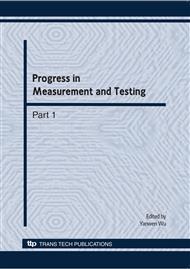[1]
R. Storn and K. Price: Differential evolution-a simple and efficient adaptive scheme for global optimization over continuous spaces, Technical report, International Computer Science Institute, Berkley, (1995).
Google Scholar
[2]
K. V. Pric, R. Storn, J. Lampinen: Differential Evolution: A Practical Approach to Global Optimization, London: Springer-Verlag, UK, (2005).
Google Scholar
[3]
T. Gong and A. L. Tuson: Differential Evolution of BinaryEncoding, Soft Computing in Industrial Application, vol. ASC 39, (2007), pp.251-262.
Google Scholar
[4]
L. B. Zhang, C. G. Zhou, M. Ma asn C. T. Sun: A multi-objective differential evolution algorithm based on max-min distance density. Journal of Computer Research and Development, (2007), 44(1): 177−184 (in Chinese with English abstract).
DOI: 10.1360/crad20070125
Google Scholar
[5]
G.Q. Zhao, X.Y. Peng and N. Sun: A modified differential evolution algorithm with hybrid optimization strategy, ACTA Electronica Sinica, (2006), 34(12): 2402−2405 (in Chinese with English abstract).
Google Scholar
[6]
N. Noman and H. Iba: Accelerating differential evolution using an adaptive local search, IEEE Trans. on Evolutionary Computation, (2008), 12(1): 107−125.
DOI: 10.1109/tevc.2007.895272
Google Scholar
[7]
B. Qian, L. Wang, and R. Hu et al: A hybrid differential evolution method for permutation flowshop scheduling, Int J Adv Manuf Technol, (2007).
Google Scholar
[8]
C. N. Andreas, L. O. Sotiris: Differential evolution for sequencing and scheduling optimization, J Heuristics, vol. 12, (2006), pp.395-411.
Google Scholar
[9]
E. Marchiori: Combining constraint processing and genetic algorithms for constraint satisfaction problems, Proc. of 7th International Conference on Genetic Algorithms, (1997), pp.330-337.
Google Scholar
[10]
P. J. M. van Laarhoven, E. H. L. Aarts, and J. K. Lenstra: Job shop scheduling by simulated annealing, Operations Research, vol. 40, (1992), pp.113-125.
DOI: 10.1287/opre.40.1.113
Google Scholar
[11]
L. Schoofs, B. Naudts: Swarm intelligence on the binary constraint satisfaction problem, Proc. of the IEEE Congress on Evolutionary Computation, Honolulu, Hawaii, USA. (2002), pp.1444-1449.
DOI: 10.1109/cec.2002.1004455
Google Scholar
[12]
Q. Y. Yang, J. G. Sun, J. Y. Zhang et al: A Hybrid Discrete Particle Swarm Algorithm for Hard Binary CSPs, Proc. of the 2nd International Conference on Natural Computation (ICNC'06) and the 3rd International Conference on Fuzzy Systems and Knowledge Discovery, Xi'an, China, LNCS 4222, (2006).
DOI: 10.1007/11881223_24
Google Scholar
[13]
C. Solnon: Ants can solve Constraint Satisfaction Problems, IEEETEC, vol. 6(4), (2002), pp.347-357.
DOI: 10.1109/tevc.2002.802449
Google Scholar
[14]
M-C Riff Rojas: Using the knowledge of the constraint network to design an evolutionary algorithm that solves csp, Proc. of the 3rd IEEE Conference on Evolutionary Computation, IEEE Computer Society Press, (1996), pp.279-284.
DOI: 10.1109/icec.1996.542375
Google Scholar
[15]
S. L. Birbil and S. C. Fang: An electromagnetism-like mechanism for global optimization, Journal of Global Optimization , (2003) , 25 (3) : 263 - 282.
Google Scholar
[16]
Debels , Reyck , Leus , et al: A hybrid scatter search/electromagnetism meta-heuristic for project scheduling, European J our2 nal of Operational Research , (2006) , 169 (2) : 638 - 653.
DOI: 10.1016/j.ejor.2004.08.020
Google Scholar
[17]
Craenen: Solving Constraint Satisfaction Problems with Evolutionary Algorithms, Ph.D. Dissertation, Vrige University, (2005).
Google Scholar
[18]
B. M. Smith: Phase transition and the mushy region in constraintsatisfaction problems, Proc. of the 11th European Conference onArtificial Intelligence, Wiley, (1994), pp.100-104.
Google Scholar
[19]
G. Onwubolu and D. Davendra: Scheduling flow shops using differential evolution algorithm, European Journal of Operational Research, vol. 171, (2006), pp.674-692.
DOI: 10.1016/j.ejor.2004.08.043
Google Scholar


